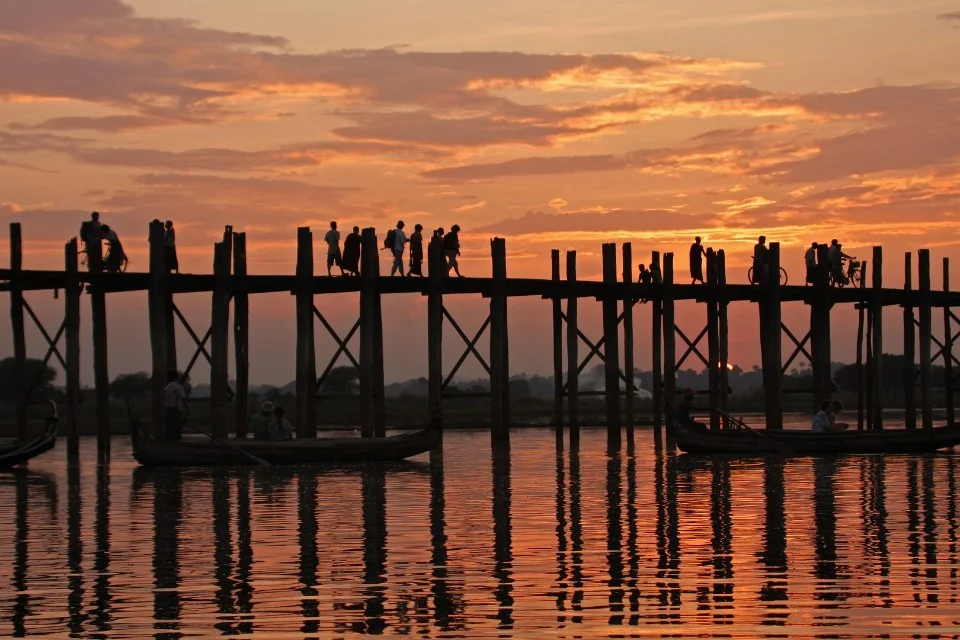Discover the Beauty and History of U Bein Bridge
U Bein Bridge, stretching across Taungthaman Lake in Myanmar, is the world’s oldest and longest teakwood bridge.

This architectural wonder, over 1.2 kilometers in length, is a cultural icon and a major tourist attraction. Built in the mid-19th century, it remains an enduring symbol of Myanmar’s history, craftsmanship, and resilience. Whether you’re a traveler, a photographer, or a history enthusiast, U Bein Bridge offers a breathtaking experience, especially during sunrise and sunset.
A Glimpse into U Bein Bridge’s History
Constructed in 1851 during the reign of King Mindon, U Bein Bridge was named after the mayor of Amarapura, U Bein, who oversaw its development. The bridge was built using teakwood salvaged from the former royal palace of Inwa (Ava), after the capital was moved to Mandalay. Its construction was not only a demonstration of resourcefulness but also an effort to connect communities across Taungthaman Lake. Over time, U Bein Bridge has witnessed historical changes, from colonial rule to Myanmar’s modern era, making it a living relic of the country’s past.
Architectural Marvel: U Bein Bridge’s Unique Structure
U Bein Bridge spans approximately 1.2 kilometers, making it the longest teakwood bridge in the world. It is supported by over 1,000 teakwood pillars, many of which have stood the test of time despite weathering and erosion. Some sections have been reinforced with concrete to ensure stability while preserving the bridge’s original aesthetic. Unlike modern bridges, U Bein’s structure lacks railings, adding to its unique, rustic charm. Walking across the bridge provides visitors with a sense of nostalgia and admiration for traditional Burmese craftsmanship.
When to Visit: The Best Times for an Unforgettable Experience
For those planning a visit, the best times to experience U Bein Bridge are during sunrise and sunset. The golden hues of the sky reflecting on Taungthaman Lake create a magical atmosphere, making it one of the most photographed spots in Myanmar. The dry season (November to April) offers clear skies and a comfortable climate, while the rainy season (May to October) brings lush greenery and higher water levels, adding a different charm to the landscape.
Things to Do Around U Bein Bridge
Beyond admiring the bridge itself, visitors can enjoy:
- Boat Rides on Taungthaman Lake: Hiring a local boat for a lake tour provides a picturesque perspective of the bridge, especially at dawn or dusk.
- Explore Mahagandayon Monastery: A visit to this nearby monastery offers insight into the daily lives of Buddhist monks.
- Taste Local Delicacies: Small eateries around the bridge serve traditional Burmese snacks, such as tea leaf salad and fried fish from the lake.
- Capture Stunning Photographs: Whether from the bridge, the water, or the surrounding fields, every angle offers a stunning shot.
U Bein Bridge in Photography and Media
This iconic bridge is a dream destination for photographers worldwide. The silhouettes of monks and locals walking across the bridge at dawn or dusk create timeless images. U Bein Bridge has been featured in numerous travel documentaries, photography contests, and social media platforms, reinforcing its status as one of Myanmar’s most scenic landmarks.
Challenges and Conservation Efforts
Despite its beauty and historical significance, U Bein Bridge faces conservation challenges. Climate change, deforestation, and increasing tourism have contributed to its gradual deterioration. Local authorities and international organizations have initiated preservation efforts, including controlled restorations and sustainable tourism practices. Travelers are encouraged to respect the bridge by avoiding damage to its structure and supporting local conservation initiatives.
Essential Travel Tips for Visiting U Bein Bridge
- How to Get There: U Bein Bridge is located near Amarapura, about 11 km from Mandalay. Taxis, motorbikes, and local buses are available for transport.
- Entrance Fees: There is no official entry fee, but donations for conservation are appreciated.
- Best Time to Visit: Early morning or late afternoon to avoid the heat and crowds.
- Safety Tips: Walk carefully as some planks may be uneven, and be mindful of local monks and pedestrians.
- Be a Responsible Traveler: Support local vendors and avoid littering to help maintain the bridge’s natural beauty.
Conclusion: Why U Bein Bridge is a Must-See Destination
U Bein Bridge is more than just a historic structure; it is a testament to Myanmar’s rich cultural heritage and resilience. Whether you seek stunning landscapes, cultural insights, or a peaceful retreat, a visit to U Bein Bridge promises an unforgettable experience. As tourism grows, it is crucial to appreciate and protect this remarkable landmark for future generations. If you’re planning a trip to Myanmar, make sure U Bein Bridge is at the top of your itinerary.